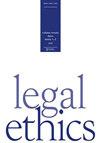The regulation of government litigants and their lawyers: the regulatory force of Victoria’s model litigant guidelines
IF 0.3
Q1 LAW
引用次数: 0
Abstract
ABSTRACT Victoria’s Model Litigant Guidelines (MLGs) aim to regulate the conduct of government parties in civil disputes in a manner that goes beyond the ethical duties of ordinary litigants. Despite the sheer number of disputes involving the Victorian government to which the regime applies, little academic attention has been given to Victoria’s MLGs. The article explores the nature and extent of the regulatory force exerted by the MLGs by applying regulatory theory to the MLG regime. Particular attention is given to applying Ayers and Braithwaite’s theory of Responsive Regulation that includes situating the guidelines within their regulatory pyramid. The analysis finds that in the absence of a distinct regulator, the MLG regime is predominantly self-regulatory. The responsiveness of the MLGs appears to be restricted owing to an absence of public involvement in the MLG regime. The article also highlights that likely challenges to the MLG regime as a mode of regulation include the nature of the regulatory context, the decentralisation of government services, the lack of publicly available information on the government’s adherence to the MLGs and the content of the MLGs themselves.政府诉讼当事人及其律师的监管:维多利亚模式诉讼准则的监管力量
《维多利亚模特诉讼指南》旨在规范政府当事人在民事纠纷中的行为,其规范超越了普通诉讼当事人的道德义务。尽管涉及维多利亚州政府的争议数量众多,但学术界很少关注维多利亚州的mlg。本文将监管理论应用于地方议会制度,探讨地方议会监管力量的性质和程度。特别注意的是应用艾尔斯和布雷斯韦特的响应性监管理论,包括将指导方针置于他们的监管金字塔中。分析发现,在没有明确监管机构的情况下,MLG制度主要是自我监管的。由于公众没有参与MLG政权,MLG的反应能力似乎受到限制。文章还强调,作为一种监管模式,MLG制度可能面临的挑战包括监管背景的性质、政府服务的分散化、缺乏关于政府遵守MLG的公开信息以及MLG本身的内容。
本文章由计算机程序翻译,如有差异,请以英文原文为准。
求助全文
约1分钟内获得全文
求助全文

 求助内容:
求助内容: 应助结果提醒方式:
应助结果提醒方式:


